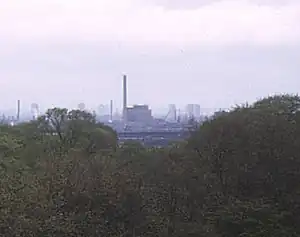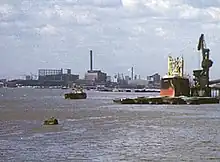Blackwall Point Power Station
Blackwall Point Power Station was a coal-fired power station on the east side of the Greenwich Peninsula, in London. An early station from the 1890s was replaced in 1951 by a new station, which itself ceased operation in 1984. The station was constructed on a three-acre site at the north-west end of River Way to the south-east of the South Metropolitan Gasworks, since redeveloped as East Parkside.
| Blackwall Point Power Station | |
|---|---|
 Blackwall Point Power Station from Greenwich Park, 1973 | |
| Country | England |
| Location | Greenwich, London |
| Coordinates | 51.497800°N 0.011500°E |
| Status | Decommissioned and demolished |
| Construction began | 1900 & 1947 |
| Commission date | 1900 & 1951 |
| Decommission date | 1947 & 1984 |
| Owner(s) | Blackheath and Greenwich Electric Light Co. subsequently the South Metropolitan Electric Light and Power Co., then the County of London Electric Lighting Co. British Electricity Authority (1948–1955) Central Electricity Authority (1955–1957) Central Electricity Generating Board (1958–1984) |
| Operator(s) | Operated by owner |
| Thermal power station | |
| Primary fuel | Coal |
| Site area | 3.5 acres |
| Chimneys | One |
| Cooling towers | None |
| Cooling source | River water |
| Power generation | |
| Units operational | 3 × 30 MW (1951 station) |
| Make and model | English Electric Company |
| Units decommissioned | All |
| Nameplate capacity | 100.5 MW[1] |
| Annual net output | see graph in text |
| External links | |
| Commons | Related media on Commons |
grid reference TQ3961079623 | |
History
The first Blackwall Point power station was built on the site of the East Greenwich tide mill by the Blackheath and Greenwich Electric Light Co. and began to supply the area in 1900. By the time it closed in 1947 it had a capacity of 15 MW.[2]

The replacement station was planned by the South Metropolitan Electric Light and Power Co. from 1947.[3] Following nationalisation of the electricity industry in 1948, planning and construction was taken over by the British Electricity Authority (BEA) which opened the station in 1952 on a small 3.5-acre site.[3] It was the first London power station designed to be fired exclusively by pulverised coal. Coal from overhead bunkers was ground to a powder by pressurised mills and transported to the furnace by air fans.[4] Coal was delivered to the station via a coaling pier on the river. The building was a steel framed structure with brick and glass cladding.[3] The box-like boiler house was to the north of the low engine room, the switch house was to the left. There was a single reinforced concrete chimney.[3]
The station was equipped with three nominal 30 MW turbo alternators generating at 11 kV and supplied by the English Electric Company, giving the station a generating capacity of 90 MW. Steam was supplied by three coal-fired Babcock & Wilcox boilers, with condenser cooling water taken from the river.[5] The maximum steam capacity of the boilers was 1,095,000 lb/hr (138 kg/s). Steam pressure and temperature at the turbine stop valves was 600 psi (41.4 bar) and 454 °C.[6] In 1954 the station used 167,000 tons of coal.[7]
The first turbo-alternator set was commissioned in the summer of 1951, subsequent sets coming into use by the spring of 1952.
Blackwall Point was originally in the London Division of the BEA, which subsequently became the Central Electricity Authority (1955–57) and from 1958 the Central Electricity Generating Board.
References
- Electrical Review,1 June 1962
- Mary Mills, Greenwich Marsh - The 300 years before the Dome, London: M.Wright, 1999, ISBN 0-9535245-0-7
- Royal Commission on the Historical Monuments of England (1995). The Power Stations of the Lower Thames. Swindon: National Monuments Record Centre.
- Frederick Gair, Blackwall Point Power Station, Greenwich Industrial History Society Newsletter, Vol 7 Issue 1, January 2004 Archived 12 May 2004 at the Wayback Machine
- Keith Doyle, Blackwall Point Power Station, Greenwich Industrial History Society Newsletter, Vol 2 Issue 4, August 1999, Archived 26 February 2009 at the Wayback Machine
- CEGB Statistical Yearbooks (various years) CEGB, London.
- "Schedule of power stations as at 31 December 1954". Electrical Review. 24 June 1955: 1123. 24 June 1955.
- "British Power Stations operating at 31 December 1961". Electrical Review. 1 June 1962: 931.
- Garcke’s Manual of Electricity Supply vol. 57, 1960, p. A-109.
- GEGB Annual report and accounts, various years
- Electricity Commission, Generation of Electricity in Great Britain year ended 31st December 1946. London: HMSO, 1947.
- Mr. Redmond (16 January 1984). "Coal-fired Power Stations". Parliamentary Debates (Hansard). Retrieved 1 September 2009.
